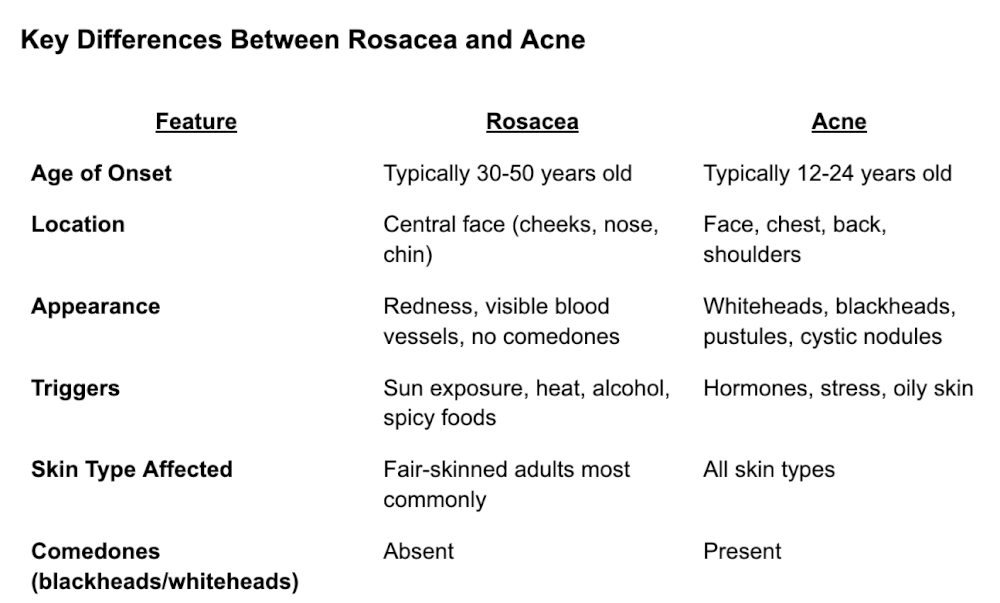Rosacea vs. Acne: How to Tell the Difference
Dr. Adam Aldahan
9/17/2025
When patients visit my Boca Raton dermatology practice with persistent redness or bumps on their face, they often assume it’s acne. However, in many cases, they are actually experiencing rosacea, a chronic inflammatory skin condition that can easily be mistaken for acne but requires a very different treatment approach. Distinguishing between these acne and rosacea is essential for effective care and long-term skin health.
What Is Rosacea?
Rosacea is a chronic skin disorder primarily affecting the central face. It is characterized by persistent redness, visible blood vessels (telangiectasias), papules and pustules, and sometimes thickening of the skin on the nose. It can rarely even involve the eyes. According to the National Rosacea Society, rosacea affects more than 16 million Americans and is most common in adults between the ages of 30 and 50, particularly those with fair skin.
Though its exact cause is unknown, rosacea is believed to result from a combination of genetic, environmental, and immune system factors. A 2017 review published in the Journal of Clinical and Aesthetic Dermatology highlights dysregulation of the innate immune system and increased Demodex mite density as key contributors to the inflammation associated with rosacea.
What Is Acne?
Acne vulgaris is a common skin condition stemming from circulating hormones in our bodies. Patients with acne often struggle with clogged pores, excess oil production, inflammation, and bacterial overgrowth, primarily Cutibacterium acnes (formerly Propionibacterium acnes). Acne typically appears as whiteheads, blackheads, papules, pustules, or cystic nodules, and it most often affects teenagers and young adults.
Acne usually starts during adolescence, although it can continue into adulthood or even begin later in life. Unlike rosacea, acne can appear not only on the face, but also on the back, chest, and shoulders.

Recognizing these differences is crucial, because the treatments for acne and rosacea are not interchangeable. In fact, certain acne treatments, such as benzoyl peroxide or harsh exfoliants, can worsen rosacea symptoms by irritating already sensitive skin.
Common Triggers and How to Manage Them
Rosacea is often triggered by environmental or lifestyle factors. According to the National Rosacea Society’s patient surveys, the most common triggers include:
- Sun exposure (81%)
- Emotional stress (79%)
- Hot weather (75%)
- Wind (57%)
- Heavy exercise (56%)
- Alcohol consumption (52%)
- Hot baths or beverages (51%)
Identifying and avoiding these triggers is a key part of rosacea management. In contrast, acne is more hormonally driven and may be worsened by stress and the use of comedogenic (pore-clogging) skincare products.
Importance of Proper Diagnosis
A board-certified dermatologist can distinguish between rosacea and acne with a physical exam and patient history. In some cases, additional testing may be used to rule out other conditions such as seborrheic dermatitis and perioral dermatitis.
Misdiagnosing rosacea as acne can delay appropriate treatment and increase the risk of skin damage, including permanent redness or thickening of the skin (phymatous changes). Early and accurate diagnosis is the best path to relief and control.
Recommended Rosacea Treatments
Rosacea treatments often focus on reducing inflammation and managing redness. These may include:
- Topical medications like metronidazole, azelaic acid, and ivermectin
- Oral antibiotics, particularly doxycycline for its anti-inflammatory properties
- Laser or light therapies to reduce visible blood vessels and redness
- Lifestyle changes to avoid personal triggers
You can learn more about my approach to treating rosacea on my Rosacea Treatment in Boca Raton page.
Recommended Acne Treatments
Acne treatment may include:
- Topical retinoids and benzoyl peroxide
- Antibiotics (topical or oral), with caution to use these sparingly
- Hormonal treatments such as oral contraceptives or spironolactone
- Isotretinoin (Accutane/Claravis) for severe or resistant cases
Final Thoughts
Differentiating between acne and rosacea can be frustrating, but with the right diagnosis and individualized care plan, most patients can achieve noticeable improvement in their skin. If you’re struggling with persistent facial redness or breakouts, I encourage you to schedule an evaluation. Getting the correct diagnosis and treatment plan is the first step toward clearer, healthier skin.
Dr. Adam Aldahan, Board-Certified Dermatologist & Mohs Surgeon, Boca Raton, FL
Palm Beach Dermatology
Recent Posts
Why Are Regular Mole Checks Important for Skin Health?
Stay proactive with regular mole checks in Boca Raton, FL for early skin cancer detection and lasting skin health through routine screenings.
The Truth About Botox: What Boca Raton Patients Should Know Before Treatment
Learn more about how Botox continues to lead the way in non-surgical cosmetic procedures in the United States.
How to Protect Your Skin in Florida Sun Year-Round | Dermatologist-Recommended
Learn how to protect your skin from Florida's intense sun with year-round dermatologist-approved tips.